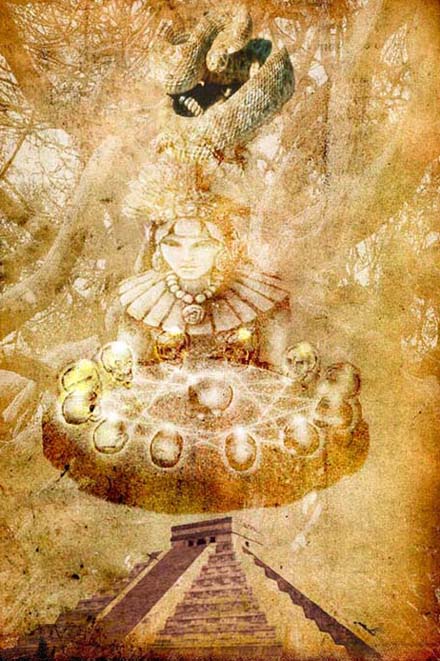It's happening people. The Lord Xenu is coming! - Spy on America.
The present-day Maya, as a whole, do not attach much significance to b'ak'tun 13. Although the Calendar Round is still used by some Maya tribes in the Guatemalan highlands, the Long Count was employed exclusively by the classic Maya, and was only recently rediscovered by archaeologists.[26] Mayan elder Apolinario Chile Pixtun and Mexican archaeologist Guillermo Bernal both note that "apocalypse" is a Western concept that has little or nothing to do with Mayan beliefs. Bernal believes that such ideas have been foisted on the Maya by Westerners because their own myths are "exhausted".[27][28] Mayan archaeologist Jose Huchm has stated that "If I went to some Mayan-speaking communities and asked people what is going to happen in 2012, they wouldn't have any idea. That the world is going to end? They wouldn't believe you. We have real concerns these days, like rain".[27]
What significance the classic Maya gave the 13th b'ak'tun is uncertain. Most classic Maya inscriptions are strictly historical and do not make any prophetic declarations.[29] Two items in the Maya historical corpus, however, may mention the end of the 13th b'ak'tun: Tortuguero Monument 6 and, possibly, the Chilam Balam.
Tortuguero
The Tortuguero site, which lies in southernmost Tabasco, Mexico, dates from the 7th century AD and consists of a series of inscriptions mostly in honor of the contemporary ruler Bahlam Ajaw. One inscription, known as Tortuguero Monument 6, is the only inscription to refer to b'ak'tun 13. It has been partially defaced; Mark Van Stone has given the most complete translation:
Tzuhtz-(a)j-oom u(y)-uxlajuun pik
- The Thirteenth [b'ak'tun] will end
(ta) Chan Ajaw ux(-te') Uniiw.
- (on) 4 Ajaw, the 3rd of Uniiw [3 K'ank'in].
Uht-oom Ek'-...
- Black ...[illegible]...will occur.
Y-em(al)...Bolon Yookte' K'uh ta-chak-ma...
- (It will be) the descent(?) of Bolon Yokte' K'uh to the great (or "red"?)...[illegible]...[19]
Very little is known about the god (or gods) Bolon Yokte' K'uh. According to an article by Mayanists Markus Eberl and Christian Prager in British Anthropological Reports, his name is composed of the elements "nine", 'OK-te' (the meaning of which is unknown), and "god". Confusion in classical period inscriptions suggests that the name was already ancient and unfamiliar to contemporary scribes.[30]He also appears in inscriptions from Palenque, Usumacinta, and La Mar as a god of war, conflict, and the underworld. In one stela he is portrayed with a rope tied around his neck, and in another with an incense bag, together signifying a sacrifice to end a period of time.[31] Despite all this, Eberl and Prager believe that the reference to Bolon Yokte' K'uh at Tortuguero is a positive one, because the fragmentary word translated above as "descent" seems to be the same one used during building dedications.[32]
Chilam Balam
The Chilam Balam are a group of post-conquest Mayan prophetic histories transcribed in a modified form of the Spanish alphabet. Their authorship is ascribed to a chilam balam, or jaguar prophet.[33]The Chilam Balam of Tizimin has been translated four times in the 20th century, with many disputes over the meaning of its passages. One passage in particular is relevant to the interpretation of the 13th b'ak'tun:
lic u tal oxlahun bak chem, ti u cenic u (tzan a cen/ba nacom)i (ciac/cha') a ba yum(il/t)exe
Maud Worcester Makemson, an archaeoastronomer, believed that this line referred to the "tremendously important event of the arrival of 13.0.0.0.0 4 Ahau 3 Kankin in the not too distant future",[34] Her translation of the line, runs:
Presently B'ak'tun 13 shall come sailing, figuratively speaking, bringing the ornaments of which I have spoken from your ancestors.
Her version of the text continues, "Then the god will come to visit his little ones. Perhaps 'After Death' will be the subject of his discourse." Makemson was still relying on her own dating of 13.0.0.0.0 to 1752 and therefore the "not too distant future" in her annotations meant a few years after the scribe in Tizimin recorded his Chilam Balam.[35] The more recent translation of Munro S. Edmonson does not support this reading; he considers the Long Count almost entirely absent from the book, since the 360-day tun was supplanted in the 1750s by a 365-day Christian year, and a 24-round maysystem was being implemented.[36] He translates the line as follows:
...like the coming of 13 sail-ships. When the captains dress themselves, your fathers will be taken.[37]
Other Chilam Balam books contain references to the 13th b'ak'tun, but it is unclear if these are in the past or future; for example, oxhun bakam u katunil (thirteen bakam of k'atuns) in the Chilam Balam of Chumayel.[38] Bolon Yokte' K'uh appears in the Chilam Balam of Chumayel to signify an apparent battle and victory over Spanish invaders.[39]
http://en.wikipedia.org/wiki/Timewave_zero#Timewave_zero_and_the_I_Ching
Conservative Political News Blog Source Site and Talk Radio




No comments:
Post a Comment